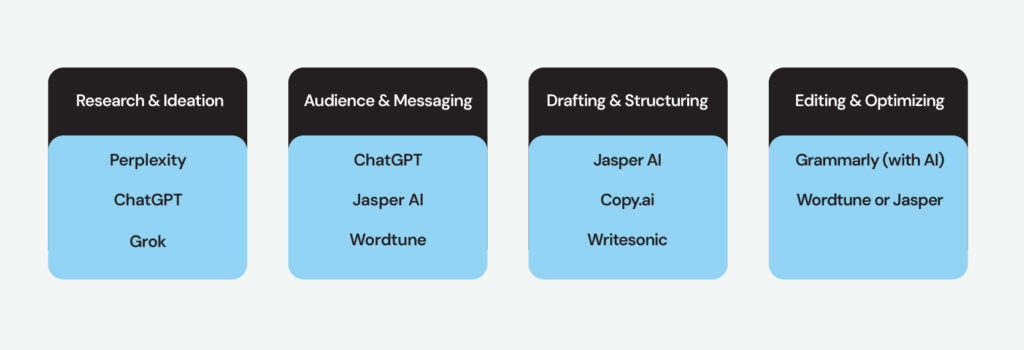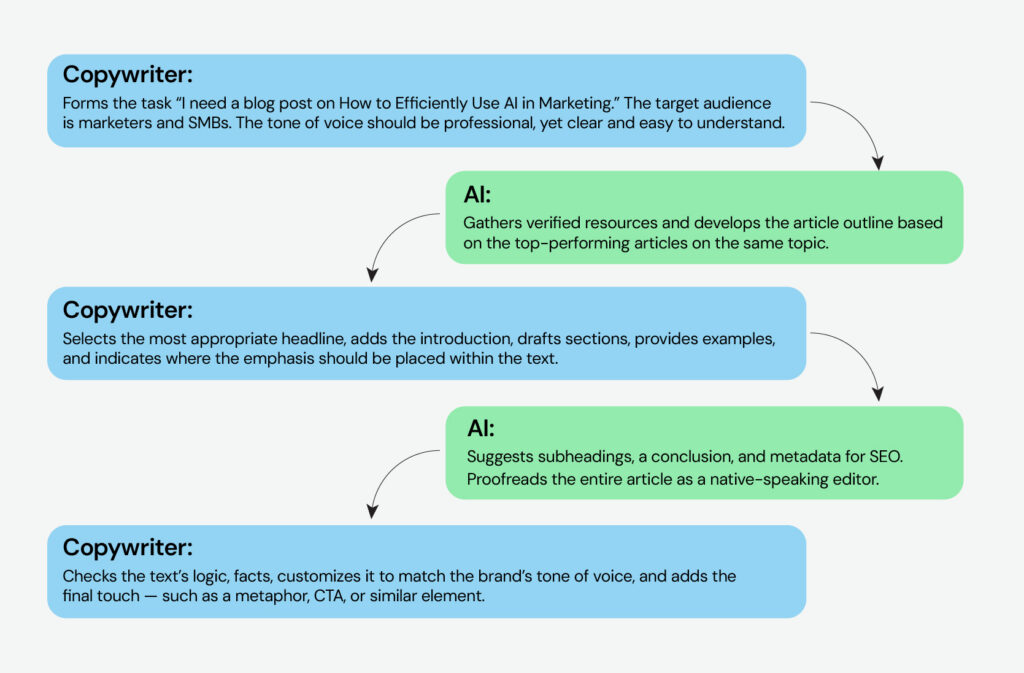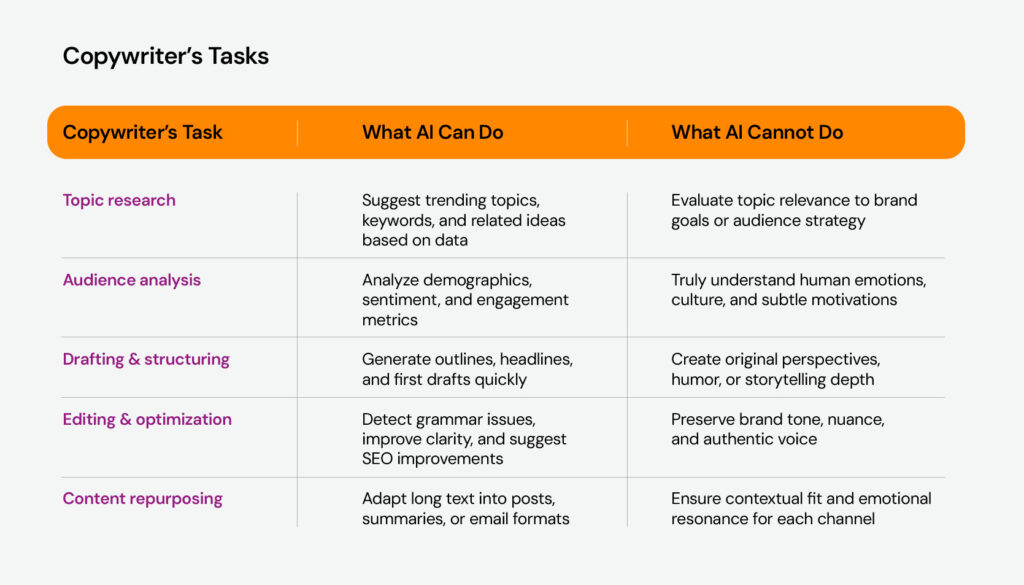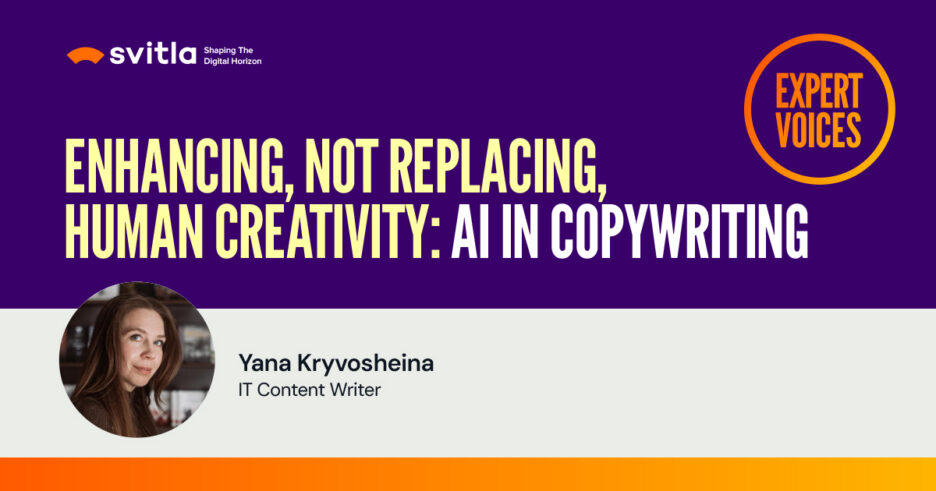“AI won't take your job — someone who learns to use it will.” This quote by Jensen Huang, NVIDIA CEO, is both hopeful and worrisome. Almost every professional in any industry has doubted whether their job will still exist after the rise and rapid growth of artificial intelligence. Copywriters are among the most concerned since their work seems easily replaceable by dedicated AI tools. The keyword here is “seems.”
In this article, you’ll learn why this is unlikely to happen in the near future and how AI genuinely assists copywriters in their daily routines to help them stay competitive.
Understanding AI in Copywriting
Firstly, let’s look at the facts. Recent research shows that AI can:
- generate ideas
- assist with text structure
- conduct comprehensive grammar checks
- create multiple variants of the same text (e.g., for SEO purposes)
- support personalization by suggesting topics (and keywords) that best resonate with the target audience.
As a result, copywriters save time for more creative or important tasks. To clarify, it’s like comparing a chef and a prep cook in a restaurant. Certainly, a chef can handle everything from peeling vegetables to plating the dish. But what's the point if there’s a prep cook?
The same applies to copywriters and AI copywriting tools: they take the preparatory and basic tasks off copywriters’ shoulders.
On the other hand, AI cannot fully:
- replace human creativity
- ensure emotional nuance and empathy
- provide deep understanding of the brand and its culture
- ensure the text’s originality and the thoroughness of the topic.
One more interesting nuance: AI isn’t funny. At first glance, this might seem like a small flaw, but it again highlights AI’s limited improvisation and creativity. And there’s nothing strange about that, because AI tools don’t think on their own — they just rely on the data they were trained on.
The AI-Human partnership formula looks as follows:

Top AI Tools That Support Human Writers
Although ChatGPT is first and foremost the AI tool everyone talks about for explaining or creating texts, many other AI tools are also helpful for copywriting.
| AI Tool | Its Value for Copywriters |
| ChatGPT | Generates ideas, text structure, provides phrasing options, and polishes the final draft. |
| Jasper | Focused more on marketing texts, SMM, and helps create customized messages. |
| Copy.ai | Copywriting ideas and options + quick content creation based on the prompt. |
| Writesonic | Combines generation and optimization to speed up the time of draft creation. |
| Grok & Gemini | More of a research and information platform that helps gather data, identify trends, and improve the quality of the text, rather than traditional copywriting. |
| Perplexity | A research tool that gathers, organizes, and evaluates resources for the chosen topic regardless of its complexity. |
Certainly, there are already more AI tools for copywriting, but I chose to focus on those I personally use (or have used) in my work routine.
To better understand how these AI writing assistants function in practice, let’s connect them to the main pillars of the copywriting workflow. These are:
- Research & ideation
- Audience & messaging strategy
- Drafting & structuring
- Editing & optimizing
The good news is that each process within these pillars can be streamlined and optimized using AI.

How AI Enhances Creativity and Efficiency
So, how exactly does AI improve human copywriters’ efficiency and spark creativity? In short, humans used to spend a lot of time on routine tasks that are now handled by AI tools. As a result, copywriters can focus more on creativity. Here are the most common tasks that AI assists copywriters with:
- Headlines generation
There’s no need to spend hours searching for the perfect phrase anymore. AI produces dozens of options in just a few seconds.
- Repurposing content
An old blog article can be repurposed into a series of LinkedIn posts, a brief email newsletter, or even a video script. You get a new, high-quality piece of content without having to create anything from scratch.
- Saving research time
High-quality content depends on thorough research. AI helps copywriters gather and organize data, keywords, stats, trends, and more. Tools like Perplexity provide specific insights and enable you to build an analytical foundation quickly.
Use case #1
How does this work in practice? Let’s check out the brief example below.

Use case #2
Another example emphasizing how to speed up the writing process is as follows:
A copywriter found a useful scheme or chart in an industry report and wants to include it in their article.
❌ Issue: They need to use an image, but the text within that image should be converted into written text. Manually typing the text would take the copywriter an additional half hour.
✅ Solution: Uploading the image to an AI tool, such as ChatGPT, and asking it to extract the text reduces this half-hour task to just a few seconds.
As you can see, human-AI collaboration makes the copywriting process quicker and more efficient without losing quality or creativity.
Common Misconceptions About AI in Copywriting
AI is very effective at generating product descriptions for online stores, especially when uniqueness or creativity isn't required. But when it comes to more imaginative writing, a skilled copywriter tends to produce better quality content.
Despite clear evidence, many still believe in the myth that “AI can fully replace human copywriters”. This conclusion relies on the assumption that all you need to do is add a prompt to the AI tool, copy the generated text, and paste it wherever needed. Fortunately for copywriters, it doesn’t actually work this way, and here’s why:
- AI lacks nuance, cultural understanding, and emotional intelligence.
AI doesn’t understand the brand’s nuances, emotional connection, or cultural context, which are all very important. In most tested scenarios, human copywriters consistently achieved higher CTRs.
- AI cannot think on its own; it uses the data it’s been trained on.
AI tools are often trained on the top search results on Bing and information from authoritative websites. However, the quality of this data can vary, and sometimes the information is not learned perfectly, especially with complex topics like technology, science, finance, or medicine. The solution here is to only double-check.
- Instead of saying "I don’t know” AI hallucinates.
As a rule, when AI doesn’t have the answer to your question, it often invents information presented as true facts. This is known as “AI hallucinations.” The problem is, until you compare this answer to several verified sources, you’ll never know the truth. Once again, double-checking is essential.
Example of an AI-generated text and its signs:
"Digital transformation is not just a trend — it’s a holistic journey that empowers organizations to leverage next-generation technologies, streamline workflows, and unlock unprecedented value across every touchpoint."
If you’re familiar with AI-generated content, you’ll quickly recognize the following signs in the sentence above.
- Overloaded with corporate jargon (holistic journey, leverage next-generation technologies, unlock unprecedented value)
- Vague but grand tone with lots of enthusiasm, little specificity
- No clear human voice or opinion, just abstract positivity
- *M-dash is considered to be a typical sign of AI.
*Personally, I think it’s unfair because an m-dash is a normal punctuation mark, and I enjoy using it throughout my writing. Other copywriters also agree with me, sharing their appreciation for m-dashes.
And here’s a summary of the key copywriter’s tasks and what AI can/cannot do in this regard:

Best Practices for Human-AI Collaboration
Let’s shift the focus from the question “Will AI replace copywriters?” to “How can AI tools assist copywriters in creating high-quality content with less time and effort?”
- Start with a detailed prompt. Clearly specify what you need: target audience, tone of voice, goal, etc. The more specific your prompt, the better the result you’ll get.
- Think of the AI-generated text (answer) as a draft or an idea source. Don’t publish it as is; use it as a foundation that you can customize, edit, and adjust as needed.
- Edit the text to ensure accuracy, alignment with the brand’s tone, and emotional impact. Add human elements such as examples, stories, or a particular style.
- Verify the facts, the uniqueness, and relevance of the content to the context. AI can make mistakes, provide false information, or be too vague without considering important details.
- Always perform final proofreading yourself. Even if AI plays a major role, a human review is essential to finalize the text.
Case Studies: AI Supporting Writers
Indeed, these are not only copywriters, but also journalists, marketers, and other related specialists are actively using AI as a creative assistant that helps significantly enhance their metrics. To prove the point, here are some real-life examples:
According to HubSpot, marketers who incorporate AI into their work routine save up to two working hours per day.
Jasper AI clients’ cases demonstrate a 40-50% increase in content creation speed and thousands of hours saved per year in large teams.
Regarding journalists, The Washington Post uses its own system — Heliograf. It allows for the automatic creation of short news, so their journalists can focus on more in-depth or analytical materials.
According to the Content Marketing Institute, this form of collaboration between humans and AI increases user engagement and streamlines the content creation cycle. However, a human remains the key player in the process, because it’s the author who decides which ideas to develop, adds the brand’s tone of voice, the suitable emotion, and uniqueness.
Future of AI in Copywriting
The collaboration between humans and AI in copywriting will only grow stronger, so it’s very helpful to stay updated on upcoming trends. The main ones are:
- Content personalization
AI systems are becoming more precise in creating personalized texts. They learn to consider the reader’s interests, behavior, and even their current emotional state. AI algorithms analyze users’ data and help copywriters set up messages customized for specific audience segments.
According to McKinsey, companies that use personalization gain a 40% increase in revenue.
- Multilingual copywriting
AI already makes it easier to work with multiple languages thanks to models like Google Gemini or ChatGPT. They assist with translating text, adapting style, and considering cultural nuances. However, human proofreading and localization will still be necessary because only human copywriters can fully convey humor, tone, and context.
- Forecast hints & analytics
Content-trend forecasting is another emerging direction for AI development. Modern systems are increasingly capable of analyzing large amounts of data to predict which topics and formats will resonate most with target audiences. It doesn’t replace creative insight but helps authors make data-driven decisions instead of relying on intuition.
- Growth of the human copywriter role
Paradoxical as it may seem, the simpler texts AI can produce, the more valuable handwritten texts become. Just like with handcrafted products today. Unique voice, original story, ability to feel the moment — these can’t be replicated by algorithms. The future of content lies with those who can blend AI analytics with human creativity and empathy.
Summing Up
AI in copywriting isn’t a “mechanical author.” Its main role is to expand human possibilities. Delegate the routine copywriting tasks to AI and focus on the key elements: gist, emotions, and impact. Words need not only to be written but also to be filled with meaning. Because anything is possible in this world, maybe, in the distant future, AI will be able to replace copywriters. But the short answer is “Not today.”





